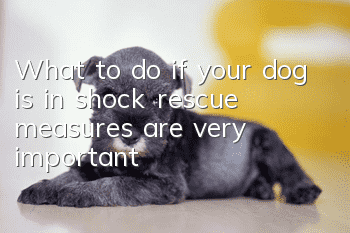What to do if your dog is in shock, rescue measures are very important

Shock symptoms in dogs
Shortness of breath and weakness.The dog appears very weak and shakes
The extremities of the body, such as legs, paws, and ears, are hypothermic, or cold.
The dog appears numb.
Oral mucosa appears white or bluish.
Press the dog's gums with your fingers and the gums will rebound slowly or not at all.
The dog lost consciousness.
The body temperature drops. If it is lower than 36.7℃, it is life-threatening.
First aid measures for dog shock
1. If there is bleeding, apply a pressure bandage before taking other measures.2. Don’t let the dog eat or drink anything.
3. Stop letting the dog run around. Instead, let him lie down on his side.
4. Keep breathing smooth, clear the respiratory tract if necessary (for example, if there is vomit), and then pull out the dog's tongue.
5. Straighten the dog’s neck.
6. Keep the dog warm.
7. Avoid noise.
8. See a veterinarian immediately.
9. Only when there is no breathing and the heart stops beating:
(1) Check eye reaction;
(2) Resuscitation and rescue;
Tips: Eye reaction Check
When the dog's heart stops beating, open its eyelids and you will see that the pupils are dilated and the eyes are dull.
If the dog's breathing stops at this time, cardiac massage or cardiopulmonary resuscitation must be performed.
Tips: CPR
Be sure to ask your veterinarian to teach you how to perform CPR on your dog. Wrong action can even cause life-threatening danger. Cardiopulmonary resuscitation can only be used when the dog has no breathing and heartbeat and will die if no rescue measures are taken.
1. The dog’s lying position
Let the dog lie on the right side of the body on a hard surface.
2. Use both hands to clasp the dog's mouth
Use both hands to clasp the dog's mouth so that the air blown in will not leak out from the dog's mouth again.
3. Artificial respiration
Put your mouth tightly against the dog’s nose, and then exhale 2-3 times.
The strength of your exhalation should be adjusted according to the size of the dog. Especially when giving artificial respiration to puppies, special attention should be paid (risk of lung rupture).
4. The position of the heart
5. Hand movements
Place the heel of one hand on the lower third of the dog’s sternum. Place the other hand on this hand.
Particularly small dogs use only their thumb and index finger to hold their chest.
6. Heart Massage
Carefully press your hands (puppy-thumb and index finger) downward rhythmically against the sternum (puppy-chest).
When touching the heart area, bothPress down with your hands briefly and firmly, then relax immediately. Repeat this heart massage action at a rhythm of about 20 times every 15 seconds.
The amount of force exerted on the hands should be adjusted according to the size of the dog's body (to avoid rib fractures).
7. Check
Check breathing and pulse
8. Other measures
Repeat this action until the dog has a spontaneous heartbeat again, until the dog can immediately before being sent to a veterinarian for treatment.
Random articles
- What do dogs eat to protect their stomach? It is important to protect their stomach and treat gastrointestinal diseases in dogs.
- How to tell if your dog is fat? Is your dog overweight?
- Will your dog catch a cold if you blow the air conditioner? What should you do if your dog catches a cold if you blow the air conditioner?
- What should you pay attention to when your dog drinks water? Don’t be careless when it comes to your dog’s drinking water.
- The dog's mouth bites and shakes. Why does the dog's mouth occasionally shake and bite?
- How to cut a dog's hair? Do you know how to cut a dog's hair correctly?
- Can dogs eat raw eggs? Why can’t dogs eat egg whites?
- Common Dog Problems in Summer How to Deal with Different Dog Problems
- How to keep dogs away from skin diseases. If you do this, will you see if your dog will still be infected with skin diseases?
- What causes anorexia in dogs? Dogs will become anorexic due to lack of exercise. Hounds run at least 5KM every day.



